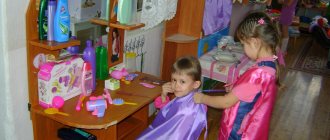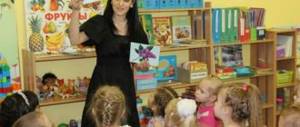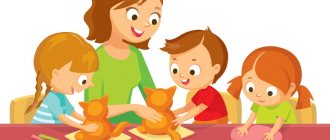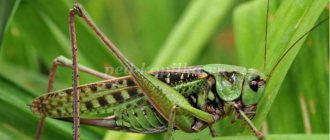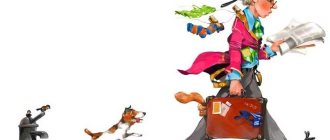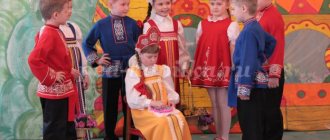Content of cultural and hygienic skills in the senior group of preschool educational institutions
In the senior preschool level, preschool pupils must improve the following skills of self-care, caring for their own body, and habits of cultural behavior:
- Constantly maintain cleanliness of the body, neatness of hair, clothes, and shoes. Moreover, all necessary procedures are carried out quickly.
- Brush your teeth yourself, following certain rules and sequence of actions.
- Keep your nails clean.
- Use a handkerchief when coughing and sneezing, turning to the side.
- Dress and undress quickly. In this case, the clothes are neatly folded in a certain place (in a locker or on a high chair).
- Tidy your bed after a nap.
- Use cutlery correctly, including fork and knife.
- Eat carefully and quietly, maintain correct posture while eating.
In the process of eating, preschoolers develop the ability to eat carefully and maintain an even posture.
An indicator of the acquisition of important skills is a gradual decrease in the time that children spend on performing a particular procedure. In addition, the quality of its implementation is also taken into account (for example, the child did not just quickly wash his hands, but thoroughly dried them, carefully hung the towel on the hook).
When working with students in their sixth year of life, the teacher pays increasing importance to the formation of moral qualities that are interconnected with hygiene habits:
- Differentiate between good and bad actions.
- Approach adults and peers with requests and thanks.
- Take care of clothing and other things, as well as the work of adults.
- Behave with restraint and follow certain rules of behavior in kindergarten, including when there is no teacher nearby.
Photo gallery: skills that need to be improved in older preschoolers
When coughing and sneezing, children learn to use a handkerchief, turning away to the side.
Pupils of the senior group should eat carefully, quietly, maintaining correct posture at the table
Children 5–6 years old can neatly make their beds after a nap
Pupils of the senior group must be able to quickly dress and undress, carefully putting clothes in a locker
In the older group, children learn to brush their teeth on their own
Role-playing game “The doll is bathing”
The purpose of the game is as follows: to consolidate children’s knowledge about washing means, to develop the ability to use them in practical activities.
Children are offered several items, including soap and a washcloth. It is these that the kids must choose from a number of others. After which, preschoolers should bathe the doll using the selected hygiene products.
Methods and techniques for developing cultural and hygienic skills in children 5–6 years old
The development of cultural and hygienic skills (CHS) is a long process. If younger preschoolers are allocated much more time for hygiene issues and self-care (this can be seen from the daily routine), then five-year-old children have, in principle, already formed important habits. The teacher’s task is to improve them and take them to a new level. We are talking about fostering a culture of communication. For example, after a walk, the guys undress, carefully putting their things in a locker. At the same time, they try not to disturb other children with their actions (after all, it happens that one child keeps the booth wide open, and because of this, there is not enough space for others). Another routine point is hand washing. It is important not only to wash them well and quickly, but not to splash water on those standing nearby, and not to push your friends (after all, there are much fewer sinks than there are preschoolers in the group).
It is important not only to perform hygiene procedures correctly, but also not to disturb other children.
In addition, during hygiene procedures and self-care, the teacher should encourage mutual assistance among preschoolers. For example, children adjust each other’s hoods or scarves before going for a walk. Similarly, during lunch, one child, at the request of another, passes him bread.
In the life of an older preschooler, the team begins to play an increasingly important role, and the interaction of its participants becomes more complicated. In the process of communication, a 5-6 year old child is able to show greater restraint and learns to act taking into account the interests of another person or a group of peers.
Of course, there are always children for whom these actions are not easy. The teacher carries out mandatory individual work with them (mainly conversations).
In the senior preschool level, the teacher forms in pupils a more conscious attitude towards cultural and hygienic habits. Children must understand that neatness (clean face, body, neat hairstyle, well-groomed clothes, shoes) is not only an elementary requirement of hygiene, but also the norm of human relations. By following simple rules, a person demonstrates respect for others, since no one wants to touch dirty hands or look at wrinkled and soiled clothes. Preschoolers, with the help of the teacher, notice that a sloppy child (one who does not know how or is lazy to take care of his appearance) is most often careless in games and activities: for example, he draws sloppily, is not able to water indoor plants well, etc.
When working with older preschoolers, ethical conversation becomes an effective method of generalizing and consolidating the CPG and associated moral ideas. Its content can be real life incidents, the behavior of people around, mainly the children themselves. The teacher, together with the students, evaluates various actions. The main task is to form moral motives of behavior in preschoolers: they will be guided by them in their future actions. An example of a topic for an ethical conversation is “How to show others with your appearance that you respect and value them.” Such conversations should not be carried out spontaneously: it is better to analyze what caused vivid impressions in the children and touch on this topic. The emotional response of the students will be evidenced by their questions, genuine emotions, and sincere assessments of the action. As a result of such communication, the child’s inner world seems to open up to the teacher, which makes it possible to further correct the child’s behavior. In addition, joint discussion of various situations generates empathy in preschoolers and enriches moral ideas.
In addition to moral conversations, the senior level widely uses educational ones, when the teacher discusses with the children certain aspects of hygiene and culture: for example, “What is the difference between shampoo and soap” (or children’s toothpaste from an adult’s), “Why is it so important to brush your teeth.” During such discussions, it is important to provide the children with interesting facts, accessible information from the history of things (for example, how the toothbrush appeared and what objects people used before its invention).
In the senior group, the teacher should actively use ethical conversations
To consolidate personal hygiene skills, it is useful for older preschoolers to give various instructions. So, in addition to mandatory duty in the canteen, the teacher can appoint a “orderly” every day. He checks with his classmates the cleanliness of their hands, the condition of their nails, the neatness of their clothes, and the order in their cubicles.
When I worked as a teacher in an older group, in the summer after a walk I always appointed a child responsible for washing their feet. He was the fastest to undress after a walk, go to the shower, sit on a chair there and pour water from the shower hose onto the legs of the other guys. You should have seen how the children asked for this honorable “position”, how important the person in charge of the shower felt!
During sensitive moments that relate to hygiene and self-care in the older group, it is useful to introduce a competitive element. For example, before eating, you need to warn children that there is a competition for the cleanest and tidiest table. After lunch, a symbolic prize is placed on the winning table - a flag, a beautiful figurine or an improvised cup.
A competitive element will help improve cultural and hygienic skills, for example, a competition for the cleanest table after lunch
As for my experience, after a nap I held a competition for the three most beautifully and quickly made beds. As an additional incentive (in addition to praise), the children were presented with candy or stickers. This technique was very stimulating for preschoolers. In addition, they felt more alert after waking up. By the way, thanks to such a sweet prize, some preschoolers even learned to insert a blanket into a duvet cover (to help the nanny change bed linen, and all this happened solely at the request of the children). This “wisdom” was mastered not only by girls, but also by boys.
When working with children of the sixth year of life (as with toddlers), a play component should be used, but it becomes noticeably more complicated. For example, you can play a game of “Allowed-Forbidden”. The teacher names various hygiene rules and their violations. Children must react accordingly. They can simply say “it’s possible” or “it’s not possible,” or the teacher adds an element of mobility to the game: in the first case, clap their hands, and in the second, cover their face with their hands. Examples of teacher statements:
- brush your teeth;
- biting nails;
- wash hair;
- have a conversation at the table while eating;
- take a shower;
- pick your nose;
- sneeze on others;
- use a handkerchief.
You can use pictures depicting each of these actions.
Another option is the board game “Match a Pair”. The manual teaches how to correlate the subject and the action and reinforces the KGN. Preschoolers are offered a variety of pictures. You need to make logical pairs out of them. For example, clothes - a closet, soap - hands, toothpaste and brush - teeth, toys - a box for them. At the same time, the guys comment on their choice.
A fun game called “Clean Crocodile” using facial expressions and pantomimes. Using a counting rhyme, a leader is selected. He must show with gestures and facial expressions the action he has planned, related to observing the rules of hygiene: for example, brushing his teeth, washing his face, getting dressed for a walk, etc. The rest of the children must guess the action.
Hygiene procedures in the older group can be accompanied by artistic words. However, this is no longer just a nursery rhyme or a short song, as in the younger or middle group, but, for example, a proverb. After the children have washed their hands after the walk, you can discuss with them the meaning of the proverb “Cleanliness is the key to health.” And based on familiar literary works (“Moidodyr” or “Fedorino’s Grief”), you can act out small scenes.
Based on familiar works on the topic of hygiene, you can act out scenes
Didactic game “Clean Crocodile”
Purpose of the game: to develop self-care skills, reinforce the rules of personal hygiene; cultivate neatness and a thrifty attitude towards health.
The rules of the game are as follows: the leader (selected using a counting rhyme) shows with gestures and facial expressions any action related to the observance of hygiene rules, for example, brushing your teeth, washing your face, getting dressed, etc. The rest of the participants guess the action.
Types of activities to develop cultural and hygienic skills in older preschoolers
Classes on the formation of CGN are most often educational. Some sample topics could be:
- What is hygiene?
- How to take care of your teeth.
- Microbes are our enemies.
- Table setting.
- How to take care of your clothes.
Experimental activities are always interesting, which can also be associated with hygiene. An example of such an activity is “Long live scented soap!” The teacher gives each child a piece of soap and, together with the preschoolers, characterizes it according to various parameters: shape, color, smell, texture. Then the guys take an impromptu excursion to a household chemicals store. On the shelves there are a variety of types of soap: toilet and bath, laundry and liquid. In this case, the teacher appears in the role of a seller and tells the children about each name (where and how it is used). The most exciting part of the lesson is the experiment with soap shavings: students pour soap shavings into flasks with water, watch their gradual dissolution and the formation of foam. As a result, children come to an important conclusion about the properties of soap: it dissolves very well in water, while forming a lot of foam.
Through experience, the guys come to the conclusion that soap dissolves well in water, forming a lush foam
Speech development activities, for example, in the form of an ethical or cognitive conversation, also contribute to the consolidation of the CPG. Let us indicate the possible options for topics:
- Let's remember how to eat properly.
- Every thing has its place.
- What can we do to maintain our health?
- How does soap differ from shampoo?
- Hair care rules.
Fiction has great educational value. For example, a suitable option for an older group is M. Zoshchenko’s story “A Stupid Story.” Its main character is the boy Petya. He is 4 years old, but his mother considers her son a completely helpless baby: she dresses, puts on shoes, and spoon-feeds him. And then one day she was in a hurry, and both of the boy’s legs ended up in one trouser leg. Moreover, for a long time no one could determine what happened and why Petya was falling: not mom, not dad, not even the doctor, who was urgently called. Only the boy Kolya, who came to visit, helped solve the riddle. As a result, the next day Petya put on his pants on his own.
You can build an interesting activity around M. Zoshchenko’s story “A Stupid Story”
After reading the story, the guys discuss it. The teacher necessarily touches on the problems of upbringing: he finds out with the children whether it is good when adults are too protective of the child, not giving him independence at all.
During the discussion, the teacher does not give preschoolers ready-made answers, but unobtrusively pushes them to reasoning and conclusions.
In the older group, you can build a lesson around a poem. This could be, for example, “Jam” by O. Grigoriev or “Purity” by D. Krupskaya. Both works clearly show children how not to behave. In the first case, the author colorfully, even with exaggeration, describes how the character eats jam with his hands. In D. Krupskaya’s poem, Purity is lost in the house, and this is not surprising.
Table: examples of poems for instilling cultural and hygienic skills (compiled based on open access materials)
| Author | Name | Poem text |
| Grigoriev O. | Jam | Sergei has no patience, He eats jam with his hands. Seryozha’s fingers are stuck together, his shirt has grown to his skin. You can’t take your feet off the floor, You can’t take your hands off your feet. Elbows and knees stuck together, Ears stuck together with jam. A pathetic sob is heard, Sergei stuck to himself. |
| Krupskaya D. | Purity | There is vanity in our house: Cleanliness is lost. We looked at Katya's in the unmade bed - Everything there was stuck together from sweets, there was no trace of cleanliness. Under the sofa in the mountains of dust, long holes were dug. We looked into the mirrors - There was complete darkness in the mirrors. We looked into the oven - We felt completely embarrassed: A dirty guy with a beard is sleeping in our frying pan. We didn’t find the purity, Apparently it was stolen by cats. |
After reading the poem, the children and the teacher actively discuss its content and highlight key points. At the same time, the children themselves must come to important conclusions.
In addition, by using imagination, the teacher can himself compose short fairy tales on the required topic, making sure to include an edifying component. For example, this is “The Tale of Shampoo”. Once upon a time there was a children's Shampoo in the world - with a beautiful bottle and cap, smelling very tasty. She was too pleased with herself and did not want anyone to take advantage of her. Therefore, when my mother took the bottle in her hands, it deliberately slipped out. And then the woman had to wash her children’s hair with adult shampoo or soap. This made their eyes sting, and the kids cried a lot. The process of washing hair became a pain for everyone. And then one day Shampoo overheard a mother complaining to her friend that her children refused to wash their hair. And from this, harmful microbes can settle on the head, and the kids will get sick. Shampoo felt sorry for the kids, and when they were sitting in the bathroom, she jumped in. The cap opened slightly and a wonderful strawberry aroma spread throughout the bath. And then the mother washed the children’s heads, and now they did not cry, but laughed. Shampoo also became happy, because you can’t live only for yourself. After all, the best thing in the world is the shining eyes and radiant smiles of babies. By the way, when the Shampoo ran out, they didn’t throw it away: the kids used it as a “sprinkler” while bathing.
While reading a fairy tale, it is advisable for the teacher to show the children its heroine - the beautiful Shampoo
Such a funny fairy tale in an unobtrusive form will enrich preschoolers’ knowledge about personal hygiene, and in addition, will contribute to the development of the best moral qualities: the desire to help others, to be happy for other people.
Five-year-old pupils can consolidate knowledge about hygiene and culture of behavior in the process of productive activities. For example, an interesting idea is to invite the children to draw a properly set table.
Being on duty in the dining room helps children practice table setting skills.
Conducting a lesson on developing cultural and hygienic skills in the senior group
A lesson on the formation of a group of groups, like any other, in the senior group of a preschool educational institution lasts no more than 25 minutes.
Motivating start to class
Although children of the sixth year of life are distinguished by greater stability of attention than in primary and secondary preschool age, in any lesson the teacher must still think through an exciting motivation. The teacher’s task is to interest the children in the proposed topic as much as possible, to intrigue them from the very beginning.
So, if the teacher shows the kids a doll with a dirty face and hands, then he asks the older group students to look around the room and see if there are any grimy dolls among them. When children find such a messy toy, they are encouraged to think about why it got so dirty and what needs to be done to correct the situation. In addition, the communication component is necessarily touched upon: “Would you like to play with such a girl?”
In the older group, the children themselves can find a grimy doll in the room and wash it
A general lesson about hygiene items can be started with a parcel where these things are located, or with riddles about them (as the teacher guesses, the teacher attaches pictures to the board):
- In the mornings and evenings He brushes and brushes our teeth, And during the day he rests, He gets bored in a glass. (Toothbrush).
- What is rain without clouds? Are you ready to go all day? As soon as I turned on the tap, the rain poured down on me. (Shower).
- It can be family, household, bath, It can be fragrant or it doesn’t smell at all, It can be different colors, sizes and shapes of any kind, But it can only be slippery with water! (Soap).
- All the girls and boys carry me in their pockets, and when I become needed, they will get me. They will clean themselves up and hide them back. (Handkerchief).
- I close my eyes tightly, rub it into my head, and then wash it off with water.
- This hair product can even be without tears. (Shampoo). Soap and girlfriend will wash Andryushka. The girlfriend danced on her back, her back became pink. (Washcloth).
If the topic of the lesson is “Hygiene and Health” (“Where Health Hides”, “How to Maintain Health”), then you can invite the children on a trip to the country of Healthy. Another option is for the children to have some character they know, for example, Masha and the cartoon “Masha and the Bear” come to visit them. The guest has a large sheet of paper in her hands: she wants to make a newspaper for forest dwellers on the topic “Where health hides,” but does not know what to write about. Preschoolers will be happy to help Masha.
The helping motive always works very well. A girl named Slastyona may come to the boys and she chews candy all the time and doesn’t know how to brush her teeth. Preschoolers will happily act as teachers: after all, they know the rules of hygiene well.
Table: summary of the lesson “Where health hides” on the formation of cultural and hygienic skills in the senior group (fragment)
| Author | Bondarenko Yu. O., MBDOU D/s No. 30 “Vesnyanka”, Evpatoria, Republic of Crimea. |
| Organizational part | To the music, the children enter the hall, the teacher draws attention to the guests. Greet guests.
|
| Main part | V.: Guys, today I want to invite you to go to the magical land of Zdoroveyka. (Knock on the door). I'll go see who came to us. (Opens the door, and Masha is there). Look, children, Masha has come to us. (From the cartoon). Masha has a rolled up newspaper in her hands. V.: Hello, Masha! What do you have? Masha: I want to make a newspaper for forest dwellers! (Shows). Q: What kind of newspaper? Masha: I called it “Where is health hidden?” I don’t know what to write there. V.: Masha, don’t be upset, the guys and I will help you. Masha: What is health? Q: Guys, which of you wants to be healthy? (Children's answers). What do you think it means to be healthy? (When you are not sick, you grow well, when you are in a good mood). Since you and I want to be healthy and strong, I suggest you go on foot. “Health Mat” (to music). Stop "Hygiene". V.: Oh, guys, look, who’s so grimy and unwashed? (This is Dirty). Dirty, don't you know that you need to wash your face? After all, dirt is microbes! Microbes can be very angry, evil, harmful. Guys, what kind of microbes? (Small, alive, dangerous). Can we see them? (No, only through a microscope). Dirty shakes his head. V.: Dirty doesn’t believe us. Let us prove it to him and conduct an “Experiment” (I will apply magic dust to my palm and shake hands with you). What did you see? (Hands became dirty). That's right, magic dust flew from my palm to yours. What needs to be done to make them clean? (Wash) A nursery rhyme with movements to music. V.: So we taught Dirty to wash his hands! But what else you need to do to look clean and tidy, you will find out if you solve the riddles! Children solve riddles. <…> Didactic game “Helpful, harmful.” Children are divided into two teams (boys and girls). There are two trays on the magnetic board - red and blue. On red you should put healthy foods, and on blue – harmful ones. Q: Look, the “Healthy Nutrition” icon has appeared. We continue our journey. (Cubes are at a distance of 1 m, they step over to the music). They meet Dunno. V.: Hello, Dunno. What are you thinking about? Dunno: I want to learn how to do exercises, but I don’t know where to start! Q: Guys, let’s teach Dunno how to do exercises? (Yes). Charging with music. V.: Look, another icon has appeared - this is “Physical exercise”. Stop “Fresh air, sun and water”. The teacher draws the children's attention to the sound of water. V.: Guys, let's listen. Sit down, you can lie down, close your eyes and imagine that we are at sea. The sun is shining, and you and I are lying on the warm sand, breathing the fresh sea air, we feel good and warm... and now we carefully get up. Here is another icon - this is “Sun, air and water are our best friends.” But it's time for us to return to kindergarten. “Health Mat” to music. V.: Guys, I see you are in a very good mood. This is very good! Now another icon has appeared - this is “Good mood”. |
| The final stage | Summing up the lesson:
V.: Let's look at the newspaper again. Let's follow all the rules and improve our health! Thank you very much, guys, I couldn’t have done it without you, and for that, here’s a treat for you (apples). Goodbye! |
| Quote from: https://konspekteka.ru/konspekt-zanyatiya-po-formirovaniyu-kulturno-gigienicheskih-navykov-na-temu-gde-pryachetsya-zdorovya/ | |
At the end of the lesson, reflection is required. The teacher clarifies with the children what they have learned, what new things they have learned, etc. This allows them to consolidate the skills they have mastered.
Video: health lesson in kindergarten
In one of the kindergartens in Krasnoyarsk, teachers and dentists held a health lesson dedicated to dental care. Senior preschoolers learned about the structure of teeth, the rules of caring for them, and watched a play about the boy Vanya, who did not want to brush his teeth and ended up in the land of Sweetness.
Video: the fairy tale about Masha and the sweet kingdom (lesson on oral hygiene)
https://youtube.com/watch?v=dUjMKQUz4Sg
The lesson with children is conducted by a fifth-year student, future dentist Vladimir Ryabov. First, he tells the children a fairy tale about a girl Masha, who did not like to brush her teeth, but loved sweets (the story is accompanied by a display of illustrations). And then one day Masha found herself in a sweet kingdom, where the evil Caries planned to destroy her teeth. After listening to the fairy tale, children will learn how to properly clean the mouth (a model of the jaw is demonstrated). Everyone comes up to the model and tries to brush their teeth themselves.
Didactic game “Good or bad?”
Goal: to develop the ability to behave correctly in society, to comply with cultural and hygienic standards; learn to assess the current situation, analyze the actions of others; develop the concept of cultural behavior.
The teacher shows children plot illustrations depicting various situations. For example, the picture shows how a child throws toys around, brushes his teeth, helps an elderly person climb the stairs, etc. Preschoolers should determine and justify the answer about which situation is positive and which is negative.
Long-term planning for KGN in the senior group
Before the start of the school year, the teacher draws up a long-term plan for the development of KGN. It indicates the content of the activity, its purpose, specific forms of work and the methodological techniques used.
The long-term plan for the senior group also includes classes on learning how to care for clothes
Table: long-term plan for developing cultural and hygienic skills in the senior group (fragment)
| Author | Kozhina Z.K., teacher at MBDOU D/s No. 69, Engels, Saratov region. | ||
| Month | Regime processes | Skill content | Methodical techniques |
| September | Nutrition | Improve the ability to hold a fork with your thumb and middle fingers, holding it on top with your index finger. | Conversation “Remember how to eat properly” |
| Dressing and undressing | Improve the ability to independently dress and undress in a certain sequence, carefully fold and hang clothes on a chair before going to bed. | Didactic exercise “Who will put the clothes correctly and quickly” | |
| Washing | Improve your washing skills:
| Reading: I. Ishchuk “My Palms” | |
| Keeping clothes and shoes in order, making the bed |
| Didactic exercise “How to make the bed” | |
| October | Nutrition | Learn to eat different types of food without changing the position of the fork in your hand, but only slightly turning your hand. | Reading N. Litvinov “The Kingdom of Cutlery” |
| Dressing and undressing. |
| Conversation “Every thing has its place” | |
| Washing | Improve your washing skills:
| Didactic exercise “Let’s tell the kids how to wash themselves” | |
| Making the bed | Continue learning how to make the bed: straighten the blanket after adjusting the sheet. | Reading: S. Mikhalkov “I myself” | |
| Quote from: https://nsportal.ru/detskiy-sad/raznoe/2015/01/13/perspektivnyy-plan-po-vospitaniyu-kulturno-gigienicheskikh-navykov | |||
In the older group, preschool children begin to be more conscious of observing the rules of personal hygiene. Children come to understand that caring for their own body and things is an important component of the general culture of behavior, the norm of human relationships. The teacher pays more attention to issues of ethics and relationships in the children's team. Cultural and hygienic skills thus become an important part of the socialization process.
